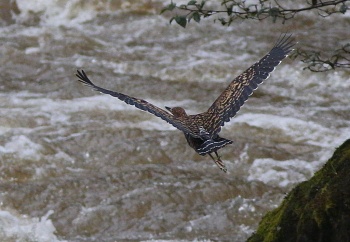- Tigrisoma fasciatum
Identification
Length 62-66cm (24-26in.)
Typical body shape of a heron, with long neck, but often not extended. Body appears overall dark at a distance, but it has a fine pattern of stripes and bars. The neck and upper breast shows a single, vertical brown stripe bordered by white or buff plumage. Yellow markings on face. Top of flat head is slaty.
Similar Species
Similar to the Bare-throated Tiger Heron this bird has slightly shorter legs, is darker with a dark bill & cap and has the white stripe running up the neck continue up to the base of the bill.
Distribution
In Central America occurs in Honduras, Costa Rica and Panama and in South America found from Colombia and Venezuela south to Bolivia and north-west Argentina with a separate area of range in south-eastern Brazil and north-east Argentina.
Taxonomy
Subspecies
There are 3 subspecies[1]:
- T. f. salmoni: is smaller and more finely-barred
- Costa Rica to Venezuela and northern Bolivia
- T. f. fasciatum:
- T. f. pallescens: is paler
- North-western Argentina
Habitat
Fast-flowing streams in humid montane forest.
Behaviour
Often stands on a boulder in mid-stream, catching fish from fast-flowing water. Patient, holds same pose for a considerable period, again typical of the family.
Diet
Their diet is not well recorded but is know to include fish and they have been observed stalking frogs.
Movements
A resident species.
References
- Clements, J. F., T. S. Schulenberg, M. J. Iliff, D. Roberson, T. A. Fredericks, B. L. Sullivan, and C. L. Wood. 2015. The eBird/Clements checklist of birds of the world: v2015, with updates to August 2015. Downloaded from http://www.birds.cornell.edu/clementschecklist/download/
- Handbook of the Birds of the World Alive (retrieved September 2015)
Recommended Citation
- BirdForum Opus contributors. (2024) Fasciated Tiger Heron. In: BirdForum, the forum for wild birds and birding. Retrieved 2 May 2024 from https://www.birdforum.net/opus/Fasciated_Tiger_Heron






